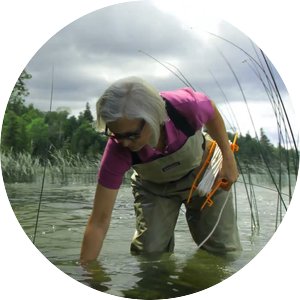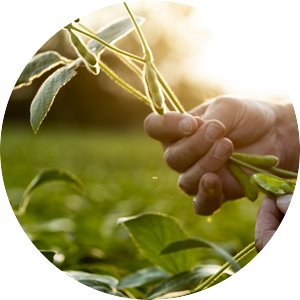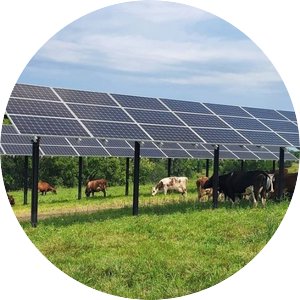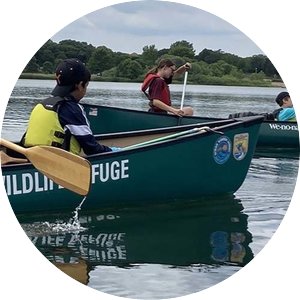
An investment in Minnesota’s future
Decades of research and discovery spanning across CFANS academic departments, collaborative centers, the Bell Museum, and the Minnesota Landscape Arboretum deliver on the mission of the Legislative-Citizen Commission on Minnesota Resources.

The challenges facing our natural environment impact our health and wellbeing, the biodiversity of our state’s flora and fauna, and our enjoyment of Minnesota’s scenic landscapes. The College of Food, Agricultural and Natural Resource (CFANS) at the University of Minnesota is committed to vital research aimed at overcoming these challenges and sustaining Minnesota’s natural resources.
Over the past twenty years, CFANS has been entrusted with more than $100 million by the Legislative-Citizen Commission on Minnesota Resources (LCCMR), stewards of the Minnesota Environment and Natural Resources Trust Fund (ENRTF). The funding has made possible dozens of projects, building on the foundation of research that the College has established throughout its history. "The funding that the LCCMR entrusts to CFANS pays dividends across the entire state. We are able to utilize the expertise of our faculty and the resources of our campus and Research and Outreach Centers (ROCs) to make discoveries that will shape Minnesota's future,” says Brian Buhr, PhD, Dean of CFANS.
This funding has been invaluable to the research of Nick Phelps, PhD, Director of the Minnesota Aquatic Invasive Species Research Center (MAISRC). "The ENRTF plays a vital role in advancing research and conservation efforts across Minnesota. Through its commitment to safeguarding our state's ecosystems, the support has become an indispensable ally in our mission to reduce the impacts of aquatic invasive species (AIS) in Minnesota.” According to Phelps, support from the ENTRF also catalyzes collaborations and partnerships—including the Minnesota Department of Natural Resources, University of Minnesota Extension, and Minnesota Sea Grant—that help researchers tackle complex problems facing our environment.
Scientists in CFANS have channeled this significant investment from the LCCMR into research with lasting impacts for Minnesotans. From the Boundary Waters of the north to the rich farmland of the south, from the air we breathe on a walk through public lands, to the water that flows through our watershed on its way to the sea—we are investing in the preservation and protection of Minnesota’s environment.
Protect and purify Minnesota waters

A land of lakes and mighty rivers, water is key to our identity as Minnesotans. From agricultural watersheds to city storm drains, CFANS is innovating approaches to protect and purify water.
- The Minnesota Aquatic Invasive Species Research Center is safeguarding Minnesota’s lakes and rivers from invasive species, from cattails along the shore to zebra mussels attached to the bottom. The Center is celebrating 10 years of aquatic invasive species research.
- The Minnesota Climate Adaptation Partnership is producing information about interactions between Minnesota’s changing climate and its water—groundwater recharge, evapotranspiration, runoff, and crop water demand. This information can be used by communities and individuals to enhance their resilience to climate change.
- Crop researchers are addressing the environmental issue of nutrient runoff from agricultural wastewater by discovering and testing crops—such as camelina—that improve the water quality and provide other environmental benefits, and have the added benefit of providing a cash crop that can be sold.
Preserving endangered plants
The rich biodiversity of Minnesota’s flora is threatened when native species are at risk. Research into science-backed conservation strategies by CFANS scientists—including experts at the Minnesota Landscape Arboretum—keeps these endangered plant species from losing ground.
- The rare Eastern hemlock is in jeopardy, with just 50 trees remaining in Minnesota. Research into the conditions that support these remaining trees will give a boost to conservation efforts in the future.
- Minnesota is home to 48 species of native orchids, 10 of which are endangered. The Minnesota Landscape Arboretum is protecting the genetics of orchids, and researching how to conserve these beloved flowers.
- The prickly ball cactus is one of Minnesota’s three native cactus species, and despite its sharp exterior, this endangered plant benefits from tender love and care from CFANS researchers. Scientists are discovering how to successfully propagate these cacti, and reintroduce them into their niche habitats.
Sustainable, pest-resistant crops

Some of Minnesota’s biggest crops are vulnerable to tiny nuisances—pests and pathogens. The Minnesota Invasive Terrestrial Plants and Pests Center (MITPPC), the only research center of its kind in the country, finds science-based solutions to protect our state’s agricultural sector. “Investments in MITPPC by the ENRTF have fueled the discovery of new technologies and techniques that are protecting Minnesota's natural and agricultural resources from invasive species,” says Robert C. Venette, Director of MITPPC at University of Minnesota.
- The recent discovery that remote sensing and artificial intelligence can be applied to the management of soybean aphid, an invasive pest that negatively impacts soybean yield and quality, has potential to save farmers time and money. Research is also ongoing into the development of soybeans that are more resistant to aphid infestations, which could decrease the need for pesticides to control the bugs.
- Both soybean and corn are subject to fungal infections that can lead to large, sudden losses. Experts in plant pathology are learning how to manage the resulting diseases including sudden death syndrome in soybeans and tar spot in corn.
Renewable energy and green agriculture

“When it comes to the intersection of energy and agriculture, the UMN WCROC has been leading the way for a long time,” says Lee Johnston, former director of operations at the University of Minnesota West Central Research and Outreach Center. Decades of research into generating and storing renewable energy by CFANS scientists and engineers move Minnesota toward its goal of carbon-free electricity. Going further, a specific emphasis on synergy between renewable energy and agriculture is creating solutions specific to Minnesota, with applications to other industries and locations.
- Wind turbines in Morris, Minnesota generate power for projects at the WCROC as well as power the University of Minnesota Morris campus. The WCROC team was able to tackle the challenge of harnessing the wind and storing its energy—in the form of hydrogen—with a grant from LCCMR in 2005. This was a proof of concept that wind energy could be feasible in the Midwest, and the starting point for further research into products that could provide value to farmers.
- Building off this success, the team piloted a method for producing nitrogen fertilizer using wind energy, the stored hydrogen gas, and nitrogen from the atmosphere. They described this as “an elegant model in which farmers could utilize wind energy that blows across their land to create a value-added nitrogen fertilizer source which can then be applied back to fields to nourish their crops.” They are now investigating the technical feasibility and economic profitability of a small-scale green fertilizer production.
- The potential of solar energy as a renewable energy source has been demonstrated, but creative solutions to integrate solar panels into productive farmland can be a win-win-win for farmers, livestock, and the environment. Research by WCROC and faculty members in the Department of Animal Science into “agrivoltaics” on dairy farms has the potential to reduce dependence on fossil fuels, lower production costs, increase land efficiency, improve forages and crops for use by dairy cattle, and increase milk production and health in dairy cows.
Reaching and teaching Minnesotans

Outreach to and conversation with the public is a critical component of scientific research and discovery. Here are a few ways that CFANS engages our community, making Minnesota’s outdoor resources more accessible and equitable.
- Nature for New Minnesotans aims to introduce English language learners to the richness of the great outdoors, through workshops with environmental educators and support from English language instructors. This initiative “hopes to increase the environmental literacy of immigrant communities in the Twin Cities in a way that empowers their use of outdoor spaces and encourages conversations about increasing equity in the outdoors for all Minnesotans.”
- The Tashjian Bee and Pollinator Discovery Center at the Minnesota Landscape Arboretum is a “hub for community education that is grounded in the world-renowned bee research of University of Minnesota scientist Marla Spivak, PhD.” This world class visitor center features macro-photography of flowers and pollinators to educate guests on Minnesota’s honey bees, wild bees, Monarch butterflies and other pollinators.
- Minnesota’s immense biodiversity, at the click of a mouse. The Bell Museum’s Minnesota Biodiversity Atlas is a comprehensive digital database of more than a century’s worth of specimens—from across the state and all seven continents. “With a few clicks, anyone from nature enthusiasts to educators can locate records of life in Minnesota and beyond,” said Keith Barker, principal investigator and Bell curator of birds and genetic resources.
These are just some of the dozens of CFANS projects made possible with the funding from the Minnesota Environment and Natural Resources Trust Fund (ENRTF) as recommended by the Legislative-Citizen Commission on Minnesota Resources (LCCMR). The Trust Fund is a permanent fund constitutionally established by the citizens of Minnesota to assist in the protection, conservation, preservation, and enhancement of the state’s air, water, land, fish, wildlife, and other natural resources. Currently 40% of net Minnesota State Lottery proceeds are dedicated to growing the Trust Fund and ensuring future benefits for Minnesota’s environment and natural resources.





